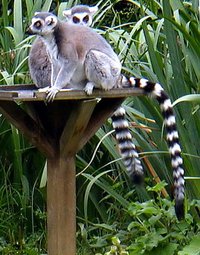Ring-tailed Lemur
|
|
| Ring-tailed Lemur Conservation status: Vulnerable | ||||||||||||||||
|---|---|---|---|---|---|---|---|---|---|---|---|---|---|---|---|---|
 | ||||||||||||||||
| Scientific classification | ||||||||||||||||
| ||||||||||||||||
| Binomial name | ||||||||||||||||
| Lemur catta Linnaeus, 1758 Template:Taxobox begin synonyms Template:Taxobox synonym entry Template:Taxobox end synonyms |
The Ring-tailed Lemur is a relatively large prosimian, a lemur belonging to the family Lemuridae. Ring-tailed Lemurs are the only species within the genus Lemur and are found only on the island of Madagascar.
Although threatened by habitat destruction and therefore listed as vulnerable by the IUCN Red List, Ring-tailed Lemurs are the most populous lemurs in zoos worldwide; they reproduce readily in captivity.
Physical description
Lemur_CinZoo_034.jpg
Mostly grey with white underparts, Ring-tailed Lemurs have slender frames; their narrow faces are white with black lozenge-shaped patches around the eyes, and black vulpine muzzles. The lemurs' trademark, their long, bushy tails, are ringed in black and white. Like all lemurs, Ring-tailed Lemurs have hind limbs longer than their forelimbs; their palms and soles are padded with soft, leathery skin and their fingers are slender and dextrous. Ring-tailed Lemurs have claws on the second toe of the hind limb specialized for grooming purposes.
The very young animals have blue eyes while the eyes of adults are all a striking yellow. Adults may reach a body length of 46 centimetres (18 inches) and a weight of 5.5 kilograms (12 pounds). Their tails are longer than their bodies, at up to 56 centimetres (22 inches) in length.
Habitat and diet
Found in the southwest of Madagascar and ranging the farthest into highland areas than any other lemur, Ring-tailed Lemurs inhabit deciduous forests with grass floors, or forests along riverbanks (gallery forests); some may also inhabit dry, open brush where few trees grow. Ring-tailed Lemurs are thought to require primary forest (that is, forests which have remained undisturbed by human activity) in order to survive; such forests are now being cleared at a troubling rate.
While primarily frugivores (fruit-eating), Ring-tailed Lemurs will also eat leaves, seeds, and the odd insect.
Behaviour and reproduction
Ring_tailed_lemur_and_twins_800.jpg
Ring-tailed lemurs are diurnal and primarily arboreal animals, forming troops of up to 25 individuals. Social hierarchies are determined by sex, with a distinct hierarchy for each gender; females tend to dominate the troop, while males will alternate between troops. The lemurs claim a sizable territory which does not overlap with those of other troops; up to 5.6 kilometres (3.5 miles) of this territory may be covered in a single day's foraging. Despite being arboreal, they spend more time on the ground than any other lemur.
Both vocal and olfactory signals are important to Ring-tailed Lemurs' communication: fifteen distinct vocalizations are used. A fatty substance is exuded from glands of the lemurs' anus and armpits, which the lemurs run their tails through; this scent is used by both sexes to mark territory, and to challenge would-be rivals amongst males. The males wave their tails vigorously high in the air in an attempt to overpower the scent of others.
The breeding season runs from April to June, with the female in estrous for only one day. Gestation lasts for about 146 days, resulting in a litter of either one or two. The young lemurs begin to eat solid food after two months and are fully weaned after five months. Males reach sexual maturity at 2.5 years and females at just 19.5 months.
Lemur_CinZoo_036.jpg
Lemur_huddle.jpg
Lemur_CinZoo_069.jpg
de:Katta fi:kissamaki ja:ワオキツネザル
